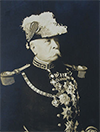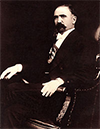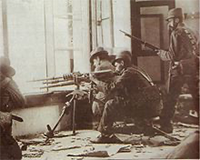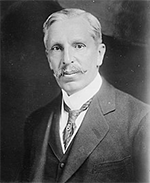Pedro Lascuráin holds the record for the shortest presidency in the history of elected government. The lawyer-politician was the leader of his home country of Mexico for less than an hour in 1913.
Born in Mexico City in 1858, Lascuráin grew up in a wealthy family, earned a law degree, and in 1910 won election as mayor of his hometown. He was involved in politics nationally and supported Francisco Madero.

The President of Mexico at that time was Porfirio Díaz (left), a general who had first come to power in 1877 and by 1910 had served as leader of the country for 31 years. Díaz, barred by the Mexican Constitution from serving more than one term, had stepped down in 1880, making way for the election of Manuel González. Díaz spearheaded a move to amend the constitution in order to allow a president to serve more than one term. He then won election in 1884 and won re-election four more times, each time proclaiming a margin of victory that observers found suspect. In the 1910 presidential election, Díaz again claimed victory; however, his main opponent, Madero, refused to recognize the result and encouraged an armed  uprising to oust Díaz. Leading the way in the Mexican Revolution, along with Madero (right), were Pascual Orozco and Pancho Villa. Much of the populace, including the army, supported the uprising, and Díaz agreed to resign. Another presidential election the following year resulted in the clear victory of Madero.
uprising to oust Díaz. Leading the way in the Mexican Revolution, along with Madero (right), were Pascual Orozco and Pancho Villa. Much of the populace, including the army, supported the uprising, and Díaz agreed to resign. Another presidential election the following year resulted in the clear victory of Madero.
One of the generals who had led the fight to quell the rebellion was Victoriano Huerta. He fought for Díaz during that leader's brief struggle to maintain power but then pledged allegiance to the newly elected Madero, proving that allegiance by following orders to put down another rebellion, led by Orozco.
Meanwhile, Madero had named Lascuráin foreign secretary, the fourth-highest-ranking official in the national government (behind the President, Vice-president, and Attorney General). The Mexico City mayor served in that capacity twice, from April 10, 1912, to Dec. 4, 1912, and then again from Jan. 15, 1913, to Feb. 19, 1913. During the two months in between his two terms as foreign secretary, he again won election as mayor of Mexico City.

By early 1913, Huerta had renounced his allegiance to Madero and secretly joined a drive to topple him. Armed conflict began on Feb. 9, 1913. Ten days later, Huerta led a coup'détat that forced Madero to leave the presidency. Many sources refer to this period of time as La Decena Trágica ("The Ten Tragic Days"). With the military firmly in control, Vice-president José María Pino Suárez also resigned and then so, too, did Attorney General Adolfo Valles Baca. Following the line of succession, Lascuráin then became President of Mexico.

Lascuráin (right) had seen the writing on the wall and throw in his lot with Huerta. When the foreign secretary became the country's leader, he named Huerta as interior minister but named no other high-ranking officials. Lascuráin then resigned, allowing Huerta to succeed him as President. Huerta had wanted his assumption of the presidency to seem constitutionally legitimate. Thus it was that Pedro Lascuráin served as President of Mexico for less than an hour. Some sources say that his term lasted only 15 minutes. The longest duration listed for his presidency is 55 minutes.
Lascuráin had assured President Madero and Vice-president Suárez that they would be safe once they resigned. Huerta declined to keep that promise and had them executed. Huerta found himself on the other end of a rebellion the very next year and went into exile. He died two years later.
Lascuráin, meanwhile, had refused Huerta's invitation to join the government, preferring to abandon politics altogether and rejoin the legal profession. He was the director of a law school for more than a decade and died in 1952, age 96.